Acer Aspire S7 Ultrabook: Acer’s Best Foot Forward
by Jarred Walton on January 7, 2013 4:30 AM EST- Posted in
- Laptops
- Acer
- Intel
- Ivy Bridge
- Aspire S7
- Ultraportable
- Ultrabook
Windows 8 Tablet Performance
As noted on the previous page, I’m going to run some of our hybrid laptops like the Aspire S7 through the tests we’re using on tablets. Much ado has been made about the performance of the latest ARM-based SoCs, and I think it’s good to put things in perspective. There are two major items of note: first is that battery life is quite a bit worse with Ivy Bridge compared to Atom and ARM SoCs; the second is that performance is nearly an order of magnitude faster in many tests.
For the tests below, note that I used the same Internet benchmark that we use for tablets, which is far less strenuous than our laptop Internet testing. In fact, the difference in battery life between our “webtest4d” and our idle battery life test is only a few minutes. Display brightness also seems to have a relatively minor impact on battery life with the S7, as it only gains an extra 5-20 minutes going from 200 nits to 100 nits brightness (depending on the test).
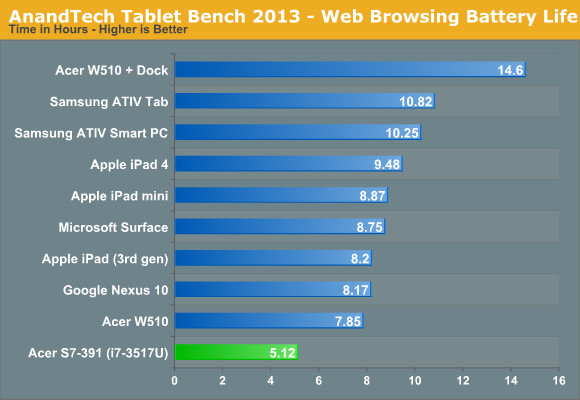
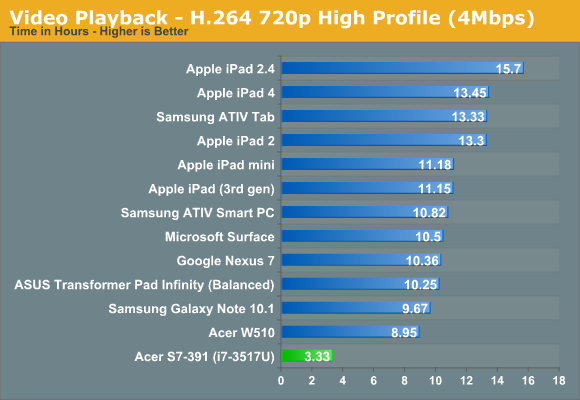
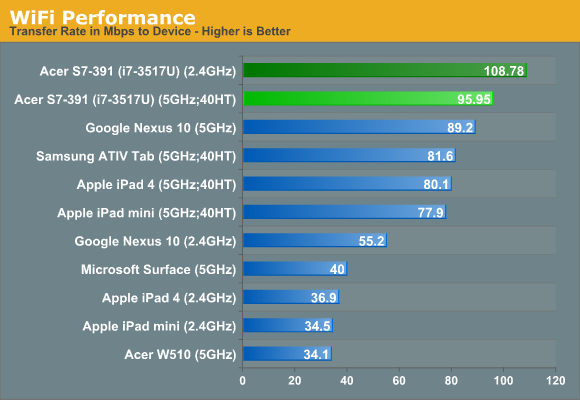
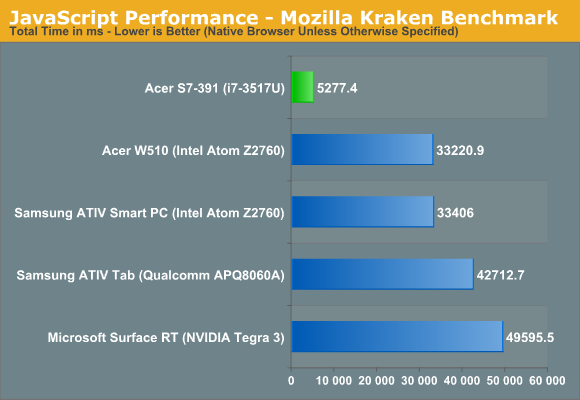
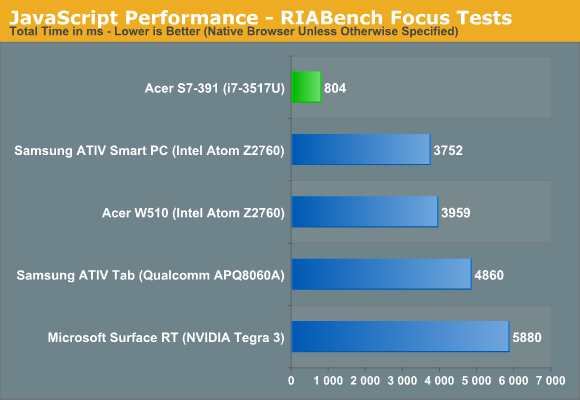
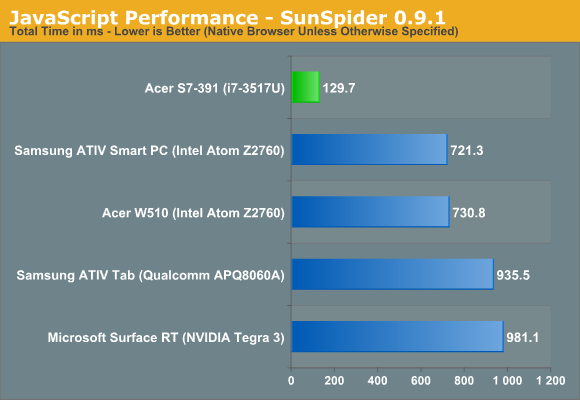
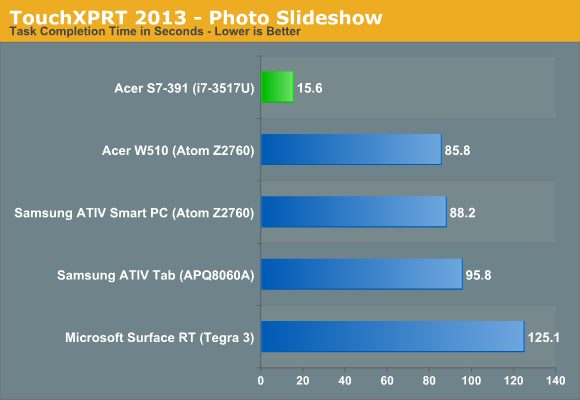
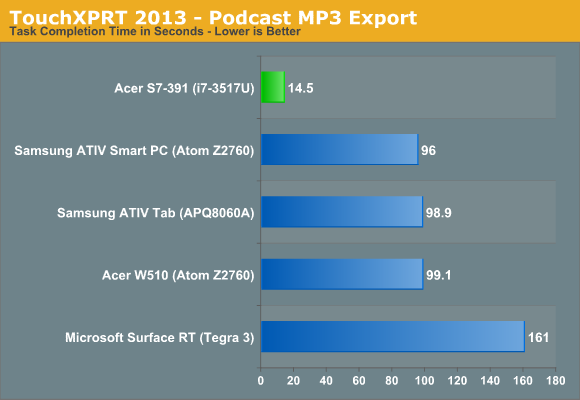
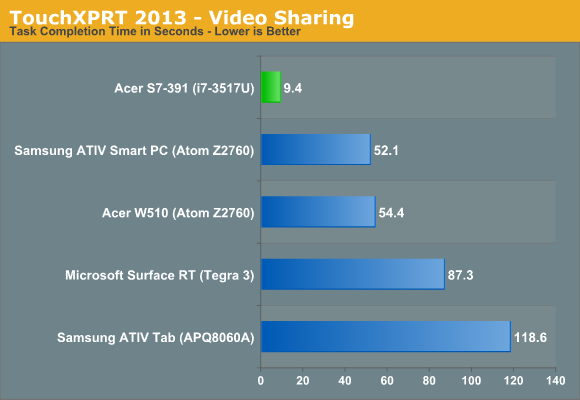
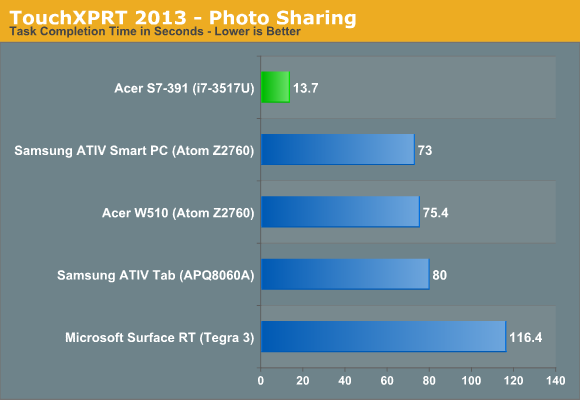
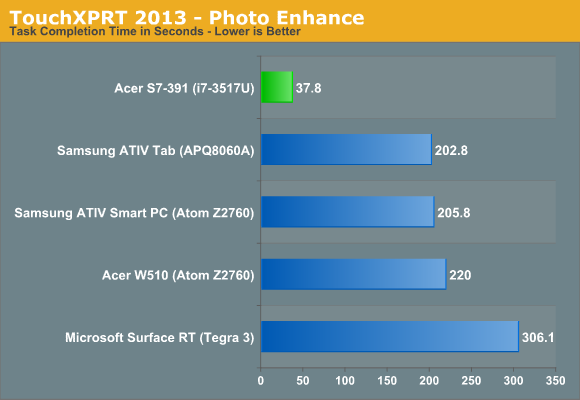
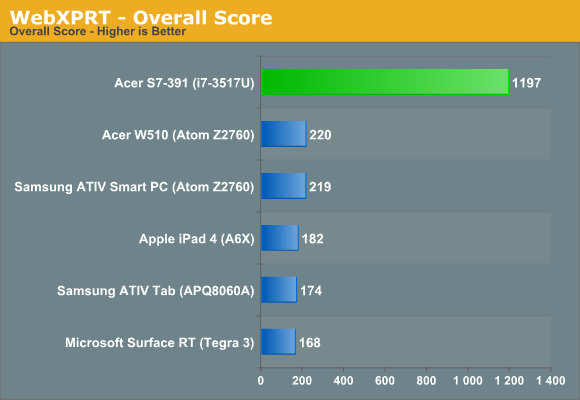
When people say that tablets are taking over for laptops, this is where we continue to fall short, and we’re not even talking about top-end laptop performance here. Bring in Haswell in the next few months and we might even see much of the battery life deficit disappear. Simply stated, ARM tablets will need much more than a doubling of performance to come anywhere near the performance level of Intel’s current ULV processors. Again, depending on what Intel manages with Haswell, it’s much more a question of whether tablets can become “fast enough” than whether they can actually catch Intel any time soon.
In terms of performance, the Aspire S7 is over 6x faster than the closest tablet in Kraken, 4.5x faster in RIABench, 5.5x faster in SunSpider, and basically 5.5x faster an all of the TouchXPRT/WebXPRT tests. In most tests, we’re looking at the Atom Z2760 as the runner up, but let’s focus on Tegra 3 just for a moment. There, Core i7-3517U is anywhere from 7-11x faster; Wayne needs to get here sooner rather than later.
It should go without saying that browsing in the Windows modern UI is smooth on the S7—though interestingly, while the touch screen interface scrolls nicely, using the touchpad to scroll around has some odd stuttering when you “coast”. Considering we have a laptop with four times as much RAM, a substantially faster SSD setup, and all that processing power, the Modern UI never appears to have a problem even on HD 4000. That’s going to make things a bit interesting for the folks at AMD and NVIDIA, depending on how the new UI and apps catch on. Then again, that new UI deserves some commentary.
Thoughts on the Windows 8 UI Experience
At best, I have serious concerns with Windows 8's new UI, at least from a laptop/desktop perspective. I said as much several months ago, and the final release has done virtually nothing to assuage my concerns. Using a touch screen to browse around works well enough, sure, but reaching across the keyboard to do so feels awkward at best. Then there’s the crazy switch between the Modern UI and the Classic Desktop UI, and the touch screen feels all but useless in the latter.
For tablets and smartphones, I think the Windows 8 UI makes tons of sense, but as soon as you slap a keyboard and touchpad in front of the user, it’s a different experience. Windows CE and earlier iterations of Windows Phone felt like Microsoft was trying to cram a full-blown desktop OS onto a handheld device without doing proper optimizations. Windows 8 feels like they’re now going the other way.
As for the Aspire S7, it does okay at straddling the line between the tablet and laptop worlds, but while I thought it was somewhat novel at first, when I got time with a Dell XPS 12 I really started to feel the faults with the S7 approach. Dell’s XPS 12 is much thicker, true, but even though the weight makes for a less than ideal tablet experience, it’s still a better tablet than the S7. Lenovo’s Yoga is another alternative, but I’m still iffy on the idea of having the keyboard exposed in tablet mode—I understand the keys all deactivate, but it just seems like a great way to get a lot of extra dirt into your keys over time. Acer has decided that instead of trying to make a true tablet-like experience, they would allow you to open the hinge 180 degrees and lay the S7 flat. I guess that can work, but in reality I almost never put a tablet flat on a table/desk; I hold it in my hands while I lounge on the couch, and the S7 doesn't feel natural in that environment.










53 Comments
View All Comments
rarson - Thursday, January 10, 2013 - link
First of all, it depends on the type of accident. I can guarantee you that a head-on collision with a wall at, say, 30 mph will be safer in a Smart Car than an Oldsmobrick.The fact of the matter is that when it comes to protecting the passenger, crumple zones and safety cages are more important than mass. Today's cars are designed to absorb the energy of the crash, to soften the impact on the passenger. Older cars were designed with the mentality that if the car survived mostly unscathed, then the passenger would as well, which is obviously incorrect. If safety is your primary concern, then you're better off looking at crash testing than vehicle size or weight. But the absolute best way to increase your safety is to become a better driver.
Tech-Curious - Thursday, January 10, 2013 - link
It's a matter of mass and size. Your guarantee is preposterous, because a Smart Car has precious little space within which to crumple, without also crumpling the people inside of it. The size of the wheelbase, the cabin, and yes, the mass of the vehicle are all important.
I've been in a head-on collision in a compact car with a much heavier object (a semi-truck). Trust me when I say that I'm lucky to be alive; if I hadn't swerved at the last second, I would have been vaporized, because the truck literally drove through the right side of my engine compartment, and didn't come to rest until its front bumper was sitting on my passenger seat.
Thank god no one was sitting there. The truck's damage? A cracked headlight.
Now, if I had been involved in the same accident in an Oldsmobrick, as you call it, the car would much more likely have kept something approaching its original shape. A passenger or I could have died from the internal trauma caused by the savage stop; that's true -- but the passenger would have died in more-or-less one piece.
Let's not kid ourselves: The Smart Car is little more than a roofed motorcycle, for all the protection it offers your body. Many modern cars are safer than their (often heavier) ancestors, but I chose the Smart Car because it represents an extreme, and I thought (erroneously, as it happens) that the extreme example would illustrate the point without courting controversy.
And yes, good driving habits comprise the best safety measure available -- but it's a mistake to assume that you're ever 100% in control of any situation on the road. The essence of safe driving is to understand that you don't have that control, to minimize your risk by putting yourself into the best position to react to sudden hazards. Even so, not all hazards are avoidable.
Tech-Curious - Thursday, January 10, 2013 - link
Oh, and with regard to crash testing, you have to be very careful. Tested safety ratings might rule out weight and size: for instance, the Smart Car recently got a safety rating similar to the Trailblazer's -- but you'd have to be out of your mind to conclude that both vehicles are equally safe.The Trailblazer is simply at the same level, relative to its analogues, as a Smart Car. A couple of statements from (or paraphrases of) the president of the Insurance Institute from Highway Safety follow:
(From http://www.msnbc.msn.com/id/24599768/ns/business-a...
(from http://usatoday30.usatoday.com/money/autos/2009-04...
(from http://usatoday30.usatoday.com/money/autos/2009-04...
And finally, the tale in pictures. Trailblazer: http://media.caranddriver.com/images/media/191279/...
Smart Car: http://node1.ecogeek-cdn.net/ecogeek/images/storie...
rarson - Thursday, January 10, 2013 - link
"Once you get to the point where the price isn't as much of an issue (especially for something you'll be using for 4-5 years) the enjoyment of using something that has high-quality interface points (monitor, keyboard, etc.) quickly overcomes the cost difference."In that case, the Acer (and the Macbook Air) fail completely. I've got a $350 Trinity laptop that I'm using right now that has a much better keyboard than both of these, and even my old PII Compaq laptop is DRASTICALLY better. I understand what you're saying about touchpads (the laptop I'm using definitely has some quirks that can make the touchpad frustrating), but I find it laughable when people call these devices "high quality" when they have such terrible keyboards.
rarson - Thursday, January 10, 2013 - link
1) Uh, every device that I've tried feels fragile in my hands due to the actual thickness, not the construction or materials. That's why I said I "feel" like I'm going to break the thing.2) Well that's just absurd. Anyone can easily see the value of a Mercedes. You can't tell the difference between a car with solid body construction and quality sound deadening? It's a pretty marked difference between, say, a typical economy car. You don't seem to understand the difference between seeing the value and actually desiring it.
There's no exceptional build quality here. The device isn't going to last longer or significantly outperform a comparably equipped, but much cheaper laptop. All you're getting is a decent display (with the added cost of touch), a slimmer chassis, and an unjustifiably higher price. So where exactly is the value proposition here?
The0ne - Monday, January 7, 2013 - link
This is an Ultrabook laptop. These are usually not cheap to begin with because they are Ultrabooks. Why are people comparing these to notebooks that are not even in the same class? These are not even in the same class as business notebooks as well. Subjectively, these are expensive because they are light and thin. Most of the readers here won't even consider buying one to be honest or may have never own an ultrabook before. The market for these are business travelers where they need the light weight and thinness to carry it around for long periods of time.I just don't understand why people would complain about something that they don't begin to comprehend what it is and what market it is aimed at.
rarson - Thursday, January 10, 2013 - link
You're right, I don't comprehend what market these are aimed at, since a regular laptop is only about a pound heavier than this thing, and might actually offer a decent keyboard and slightly larger screen real estate, things that I'm pretty sure would be far more important to the average businessman than "thin and light," at a significantly lower price, no less.Perhaps you could explain to me why a businessman would need a touchscreen on a laptop, or 1080p resolution in a 13" screen.
You said it above: "These are usually not cheap to begin with because they are Ultrabooks." Right, they are'nt cheap because they're marketed as expensive devices. I'm sure it costs more money to make the thinner, lighter chassis. But that doesn't mean that it makes sense to pay more for it.
jabber - Monday, January 7, 2013 - link
.....did we get a indication of what this machine is like out of the box?In other words -
1. How long did it take from first switch on till actually being able to use it properly?
2. How much crapware was installed and how long did it take to uninstall?
I have known Acer laptops (and others from similar companies) to take a couple of hours messing around till you can actually use them. I love the ones that force you to burn a set of recovery disks at start up and threaten thats its a once in a lifetime deal.
bobjones32 - Thursday, January 10, 2013 - link
I posted elsewhere in this thread with my impressions, but my wife purchased this from a Microsoft Store. That means it comes with a Signature image, so no bloatware, and ready to use straight out of the box.The thing turned on instantly, set up quickly, and she was using it fully within just a few minutes.
thesavvymage - Tuesday, January 8, 2013 - link
I seriously do not understand on having the "thinnest" laptop you can have. You dont hold it in your hands, it sits on your lap. The screen size and overall volume are what matters the most (for bulk). This laptop is .5" thick. If they even increased it to .7", they couldve added a bigger batter and better cooling, and it wouldnt even seem that different to anyone without a milimeter caliper.